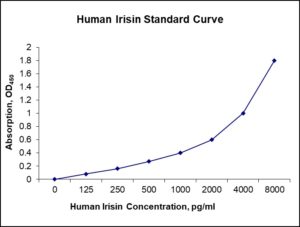Nori Human Irisin ELISA Kit
$461.00 – $832.00
This ELISA kit is for quantification of FNDC5 in human. This is a quick ELISA assay that reduces time to 50% compared to the conventional method, and the entire assay only takes 3 hours. This assay employs the quantitative sandwich enzyme immunoassay technique and uses biotin-streptavidin chemistry to improve the performance of the assays. An antibody specific for FNDC5 has been pre-coated onto a microplate. Standards and samples are pipetted into the wells and any FNDC5 present is bound by the immobilized antibody. After washing away any unbound substances, a detection antibody specific for FNDC5 is added to the wells. Following wash to remove any unbound antibody reagent, a detection reagent is added. After intensive wash a substrate solution is added to the wells and color develops in proportion to the amount of FNDC5 bound in the initial step. The color development is stopped, and the intensity of the color is measured.
Alternative names for irisin: Fibronectin type III domain-containing protein 5, FNDC5, FRCP2
This product is for laboratory research use only not for diagnostic and therapeutic purposes or any other purposes.
- Description
- How Elisa Works
- Product Citation (0)
- Reviews (0)
Description
Nori Human Irisin ELISA Kit Summary
Alternative names for irisin: Fibronectin type III domain-containing protein 5, FNDC5, FRCP2
| Assay Type | Solid Phase Sandwich ELISA |
| Format | 96-well Microplate or 96-Well Strip Microplate |
| Method of Detection | Colorimetric |
| Number of Targets Detected | 1 |
| Target Antigen Accession Number | Q8NAU1 |
| Assay Length | 3 hours |
| Quantitative/Semiquantitative | Quantitative |
| Sample Type | Plasma, Serum, Cell Culture, Urine, Cell/Tissue Lysates, Synovial Fluid, BAL, |
| Recommended Sample Dilution (Plasma/Serum) | No dilution for sample <ULOQ; sufficient dilution for samples >ULOQ |
| Sensitivity | 25 pg/mL |
| Detection Range | 125-8000 pg/mL |
| Specificity | Human Irisin |
| Cross-Reactivity | < 0.5% cross-reactivity observed with available related molecules, < 50% cross-species reactivity observed with species tested. |
| Interference | No significant interference observed with available related molecules |
| Storage/Stability | 4 ºC for up to 6 months |
| Usage | For Laboratory Research Use Only. Not for diagnostic or therapeutic use. |
| Additional Notes | The kit allows for use in multiple experiments. |
Standard Curve
Kit Components
1. Pre-coated 96-well Microplate
2. Biotinylated Detection Antibody
3. Streptavidin-HRP Conjugate
4. Lyophilized Standards
5. TMB One-Step Substrate
6. Stop Solution
7. 20 x PBS
8. Assay Buffer
Other Materials Required but not Provided:
1. Microplate Reader capable of measuring absorption at 450 nm
2. Log-log graph paper or computer and software for ELISA data analysis
3. Precision pipettes (1-1000 µl)
4. Multi-channel pipettes (300 µl)
5. Distilled or deionized water
Protocol Outline
1. Prepare all reagents, samples and standards as instructed in the datasheet.
2. Add 100 µl of Standard or samples to each well and incubate 1 h at RT.
3. Add 100 µl of Working Detection Antibody to each well and incubate 1 h at RT.
4. Add 100 µl of Working Streptavidin-HRP to each well and incubate 20 min at RT.
5. Add 100 µl of Substrate to each well and incubate 5-30 min at RT.
6. Add 50 µl of Stop Solution to each well and read at 450 nm immediately.
Background:
Fibronectin type III domain-containing protein 5, the precursor of irisin, is a protein that is encoded by the FNDC5 gene.[1] Irisin is a cleaved version of FNDC5, named after the Greek messenger goddess Iris.[2] FNDC5 is a membrane protein comprising a short cytoplasmic domain, a transmembrane segment, and an ectodomain consisting of a ~100 kDa fibronectin type III (FNIII) domain. Exercise causes increased expression in muscle of peroxisome proliferator-activated receptor gamma coactivator 1 alpha (PGC-1alpha), which is involved in adaptation to exercise. In mice, this causes production of the FNDC5 protein which is cleaved to give a new product irisin.[2] Due to its production through a mechanism initiated by muscular contraction, irisin has been classified as a myokine.[3] Based on the findings that FNDC5 induces thermogenin expression in fat cells, overexpression of FNDC5 in the liver of mice prevents diet-induced weight gain, and FNDC5 mRNA levels are elevated in human muscle samples after exercise, it has been proposed that irisin promotes the conversion of white fat to brown fat in humans which would make it a health promoting hormone. However this proposal has been challenged[21] because FNDC5 is upregulated only in highly active elderly humans.[16] In mice, irisin released from skeletal muscle during exercise acts directly on bone by increasing cortical bone mineral density, bone perimeter and polar moment of inertia.[4]
References
- Erickson HP (2013Adipocyte. 2 (4): 289–93.
- Boström P, et al. (2012). Nature. 481 (7382): 463–8.
- Pedersen BK, Febbraio MA (2008). Physiological Reviews. 88 (4): 1379–406.
- Colaianni G, et al. (2015). Proc Nat Academy Sci of USA. 112 (39): 12157–62.
Be the first to review “Nori Human Irisin ELISA Kit”
You must be logged in to post a review.






























Reviews
There are no reviews yet.